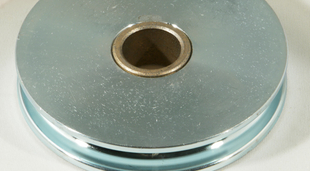Pottery Kiln Misc-Hardware
DaVinci Bell-Lift System Pulley - Unit is the pulley wheel that the cable used to hoist the Kiln Bell runs along
DaVinci Counterbalance System Eyebolt - Unit is used on the sides of all DaVinci Lids as an anchor to which the Safety Chains are attached
These are the metal hinges that get attached to the kiln case and mate with the hinge parts that are welded to the element cover boxes. There are two hinge parts and four mounting screws.
Hardware for Attaching Stand Legs with PEM Nuts - Includes eight 1/4" Long #20 (1/4-20) Bolts.
Hex Head #10 2-1/2 Self-Tapping Screw for mounting EL Terminal Blocks, Stainless 400 Series
Cotter Pins for All Hinge Bars - Unit includes a set of two Pins
Knob for the INF Infinite Zone Switch
#8 Lid Safety Chain - Unit is precut to 28" Long, comes with Mounting Hardware, and is used to secure the Kiln Lid to the Top Ring
#8 Lid Safety Chain - Unit is precut to 16" Long, comes with Mounting Hardware, and is used to secure the Kiln Lid to the Top Ring
Mounting Kit for Long Type K Thermocouples - Kit includes two #8 3" Screws, six 1/2" high Ceramic Spacers, and is used for all Pyrocil Type K and all Long 8 Gauge Type K (Exposed) Thermocouples
#8 Safety Chain - Unit is sold by the foot
Complete Safety Chain Assembly - Assembly includes the Safety Chain, Snap Clip, Screw Hook, and any Hardware
Snap Clip for the Safety Chain System - Unit should be attached to the end of the Safety Chain to hook onto the Screw Hook
#10-24 Zinc-Plated Hex Nut - Unit is used for mounting the Vent Bypass Box, Contactor Plate in the Control Panel, and for the Element Terminal Bolts

 December 5, 2025
December 5, 2025